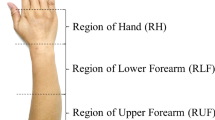Abstract
The tracking and prediction of hand and finger movements along with gesture recognition is an active subject of research due to its vast applications in many fields, such as prosthetic control and robotic telemanipulation of rehabilitation and assistive devices. The common challenge in all of these fields is developing a control interface for operating an automated assistive device in a more precise and human-like manner. In this paper, we aim to study the possibility of using a force-sensing resistors (FSRs) strap for the continuous prediction of finger movements, specifically those of the thumb and middle and index fingers. An array of 8 FSRs is used to construct a wearable band that wraps around the forearm. Ten healthy volunteers participated in this study. The subjects were asked to perform 3 representative grasping motions. The relative displacements of the tips of the thumb and middle and index fingers with respect to a reference marker placed on the hand (slightly above the wrist) was captured using a camera and colored marker system. An epsilon-based function of support vector regression with a radial basis function kernel is employed to train a regression model using the force myography (FMG) signal acquired from the forearm with the displacement of each fingertip. The results demonstrate the feasibility of using an FSR band for continuously predicting the displacement of the fingertips with an average squared correlation coefficient of 0.96 for the thumb and middle and index fingers, spanning three types of grasp.






Similar content being viewed by others
References
Khushaba, R. N., Kodagoda, S., Takruri, M., & Dissanayake, G. (2012). Toward improved control of prosthetic fingers using surface electromyogram (EMG) signals. Expert Systems with Applications, 39(12), 10731–10738.
Scheme, E., & Englehart, K. (2011). Electromyogram pattern recognition for control of powered upper-limb prostheses: State of the art and challenges for clinical use. Journal of Rehabilitation Research and Development, 48(6), 643–659.
Harwin, W. S. (1999). Robots with a gentle touch: Advances in assistive robotics and prosthetics. Technology and Health Care, 7(6), 411–417.
Harwin, W. S., Tariq, R., & Richard, A. F. (1995). A review of design issues in rehabilitation robotics with reference to North American research. IEEE Transactions on Rehabilitation Engineering, 3(1), 3–13.
Burdea, G., & Coiffet, P. (2003). Virtual reality technology. New York: Wiley.
Clark, J. F. A. (2013). New generation of ADS capabilities. Marine Technology Society Journal, 47(6), 73–79.
King, C. H., Chen, T. L., Fan, Z., Glass, J. D., & Kempa, C. C. (2012). Dusty: An assistive mobile manipulator that retrieves dropped objects for people with motor impairments. Disability and Rehabilitation: Assistive Technology, 7(2), 168–179.
Raez, M. B. I., Hussain, M. S., & Mohd-Yasin, F. (2006). Techniques of EMG signal analysis: Detection, processing, classification and applications. Biological Procedures Online, 8, 11–35.
Sheridan, T. B. (1992). Telerobotics, automation, and human supervisory control. Boston, MA: The MIT Press.
Reddy, N. P., & Gupta, V. (2007). Toward direct biocontrol using surface EMG signals: Control of finger and wrist joint models. Medical Engineering & Physics, 29(3), 398–403.
Kováč, J., Ďurovský, F., & Varga, J. (2014). Integrated system of mixed virtual reality based on data glove CyberGlove II and robotic arm MechaTE Robot. Applied Mechanics and Materials, 611, 239–244.
Kessler, G. D., Hodges, L. F., & Walker, N. (1995). Evaluation of the CyberGlove as a whole-hand input device. ACM Transactions on Computer-Human Interaction (TOCHI), 2(4), 263–283.
Jo, I., Park, Y., & Bae, J. (2013). A teleoperation system with an exoskeleton interface. In IEEE/ASME International Conference on Advanced Intelligent Mechatronics (AIM).
CyberGlove, CyberGlove II specifications. Retrieved October 26, 2015, from http://www.cyberglovesystems.com/cyberglove-ii/#specs.
Vogel, J., Castellini, C., & Smagt, P. (2011). EMG-based teleoperation and manipulation with the DLR LWR-III. In IEEE/RSJ International Conference on Intelligent Robots and Systems (IROS).
Khokhar, Z. O., Xiao, Z. G., & Menon, C. (2010). Surface EMG pattern recognition for real-time control of a wrist exoskeleton. Biomedical Engineering Online, 9(1), 41–57.
Castellini, C., & Smagt, P. (2009). Surface EMG in advanced hand prosthetics. Biological Cybernetics, 100(1), 35–47.
Al-Timemy, A. H., Bugmann, G., Escudero, J., & Outram, N. (2013). Classification of finger movements for the dexterous hand prosthesis control with surface electromyography. IEEE Journal of Biomedical and Health Informatics, 17(3), 608–618.
Honda, Y., Weber, S., & Lueth, T. C. (2007). Intelligent recognition system for hand gestures. In IEEE CNE’07. 3rd International IEEE/EMBS Conference on Neural Engineering.
Yungher, D., & Craelius, W. (2007). Discriminating 6 grasps using force myography of the forearm. In Proceedings of the American Society of Biomechanics Northeast Conference, University of Maryland, MD.
Smith, R. J., Tenore, F., Huberdeau, D., Etienne-Cummings R., & Thakor, N. V. (2008). Continuous decoding of finger position from surface EMG signals for the control of powered prostheses. In 30th Annual International Conference of the IEEE Engineering in Medicine and Biology Society (EMBS).
Ngeo, J. G., Tamel, T., & Sihbata, T. (2014). Continuous and simultaneous estimation of finger kinematics using inputs from an EMG-to-muscle activation model. Journal of Neuroengineering and Rehabilitation, 11(1), 122–135.
Li, N., Yang, D., Jiang, L., Liu, H., & Cai, H. (2012). Combined use of FSR sensor array and SVM classifier for finger motion recognition based on pressure distribution map. Journal of Bionic Engineering, 9(1), 39–47.
Nishikawa, D., Yu, W., Yokoi, H., & Kakazu, Y. (2001). On‐line learning method for EMG prosthetic hand control. Electronics and Communications in Japan (Part III: Fundamental Electronic Science), 84(10), 35–46.
Xiao, Z. G., & Menon, C. (2014). Towards the development of a wearable feedback system for monitoring the activities of the upper-extremities. Journal of Neuroengineering and Rehabilitation, 11(1), 1–13.
Castellini, C., & Ravindra V. (2014). A wearable low-cost device based upon force-sensing resistors to detect single-finger forces. In 5th IEEE RAS & EMBS International Conference on Biomedical Robotics and Biomechatronics.
Gonzalo, A. G., Okuno, R., & Akazawa, K. (2013). Simulator of a myoelectrically controlled prosthetic hand with graphical display of upper limb and hand posture. Electrodiagnosis in New Frontiers of Clinical Research,. doi:10.5772/55503.
Phillips, S. L., & Craelius, W. (2005). Residual kinetic imaging: A versatile interface for prosthetic control. Robotica, 23, 277–282.
Interlink Electronics. FSR Force Sensing Resistors integration guide. Document Part Number 94-00004 Rev B.
Stone, R. J., & Stone J. A. (2003). Atlas of skeletal muscles. New York: McGraw-Hill
Townsend, W. T. (2000). MCB—industrial robot feature article—Barrett hand grasper. Industrial Robot: An International Journal, 27(3), 181–188.
Chinellato, E., Fisher, R. B., Morales, A., & Pobil, A. P. (2003). Ranking planar grasp configurations for a three-finger hand. In IEEE International Conference on Robotics and Automation (ICRA’03), Vol. 1.
Miller, A. T., Knoop, S., Christensen, H. I., & Allen, P. K. (2003). Automatic grasp planning using shape primitives. In IEEE International Conference on Robotics and Automation (ICRA’03), Vol. 2.
Felip, J., & Morales, A. (2009). Robust sensor-based grasp primitive for a three-finger robot hand. In IEEE/RSJ International Conference on Intelligent Robots and Systems (IROS).
Cutkosky, M. R. (1989). On grasp choice, grasp models, and the design of hands for manufacturing tasks. IEEE Transaction on Robot Automation, 5(3), 269–279.
Napier, J. R. (1956). The prehensile movements of the human hand. Journal of Bone and Joint Surgery, 38(4), 902–913.
OpenCV, Learning. Computer vision with the OpenCV library. GaryBradski & Adrian Kaebler-O’Reilly (2008).
Chang, C. C., & Lin, C. J. (2011). LIBSVM: A library for support vector machines. ACM Transactions on Intelligent Systems and Technology (TIST), 2(3), 27.
Drucker, H., Burges, C. J. C., Kaufman, L., Smola, A. J., & Vapnik, V. N. (1997). Support vector regression machines. Advances in Neural Information Processing Systems, 9, 155–161.
Cherkassky, V., & Ma, Y. (2003). Comparison of model selection for regression. Neural Computation, 15(7), 1691–1714.
Basak, D., Pal, S., & Patranabis, D. C. (2007). Support vector regression. Neural Information Processing-Letters and Reviews, 11(10), 203–224.
Vapnik, V. (1963). Pattern recognition using generalized portrait method. Automation and Remote Control, 24, 774–780.
Refaeilzadeh, P., Tang, L., & Liu, H. (2007). On comparison of feature selection algorithms. In Proceedings of AAAI Workshop on Evaluation Methods for Machine Learning II.
Acknowledgments
This research was supported by the Natural Sciences and Engineering Research Council of Canada (NSERC), the Canadian Institutes of Health Research (CIHR), and the Michael Smith Foundation for Health Research (MSFHR).
Author information
Authors and Affiliations
Corresponding author
Ethics declarations
Conflict of interest
The authors declare that they have no conflict of interest.
Rights and permissions
About this article
Cite this article
Kadkhodayan, A., Jiang, X. & Menon, C. Continuous Prediction of Finger Movements Using Force Myography. J. Med. Biol. Eng. 36, 594–604 (2016). https://doi.org/10.1007/s40846-016-0151-y
Received:
Accepted:
Published:
Issue Date:
DOI: https://doi.org/10.1007/s40846-016-0151-y




